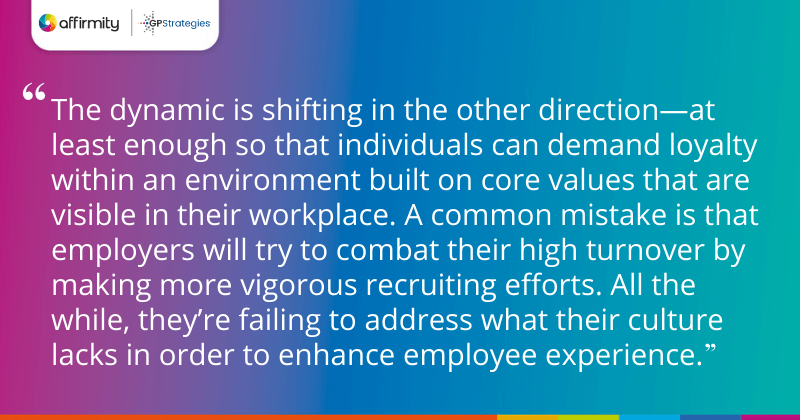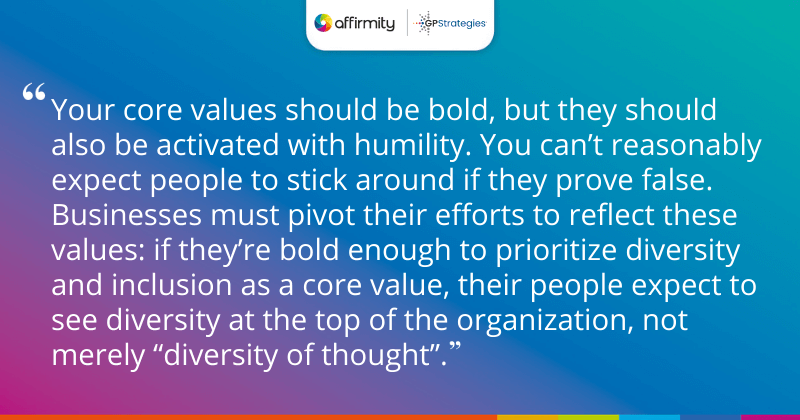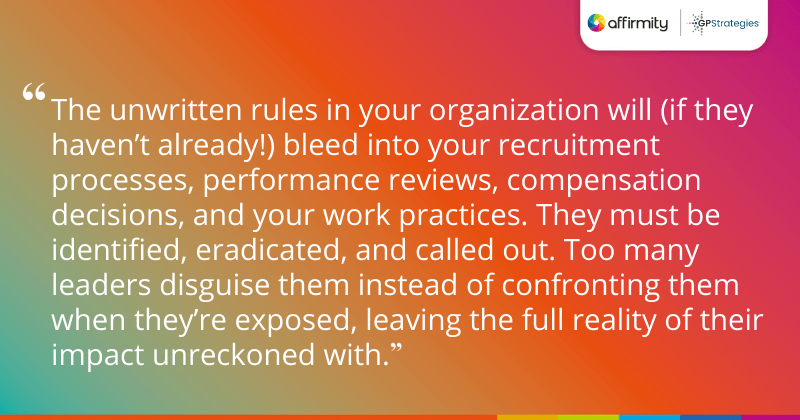Your people thrive in an employee-centric environment, a fact unchanged by pandemic-based disruption. In fact, the call for truly inclusive workplaces and the growing impatience with those that fail to deliver them are among the many factors fueling the Great Resignation. Nicole A. Simmonds-Jordan, Global Account Director at PDT Global, a part of Affirmity, examines why—and how—businesses must live out their core values.
Every month, for six consecutive months after July 2021, over 4 million Americans quit their jobs. The number of hires actually outpaced those that quit: 6.3 million American workers started new jobs in January 2022. Employees currently feel able to monopolize the market in their favor, and are happy to flee from workplaces that fall short of their expectations.
Many organizations saw the problems that the pandemic would create for their workforces: the commendable reaction to the threat to mental health was an example of this. However, as people began to therapize themselves, there was a recognition that their values were simply not being reaffirmed in their current position.
We’re all used to a world where employers have the upper hand and expect loyalty from their employees. However, the dynamic is shifting in the other direction—at least enough so that individuals can demand loyalty within an environment built on core values that are visible in their workplace. A common mistake is that employers will try to combat their high turnover by making more vigorous recruiting efforts. All the while, they’re failing to address what their culture lacks in order to enhance employee experience.

MORE FROM THE BLOG | ‘4 Steps to Help You Flip Your Classroom and Shake Up Your Inclusion Training’
Prospective employees are attracted to employers that market themselves on high standards of employee treatment. Employers find themselves scrambling to strengthen their retention and succession plans in an effort to get ahead of their employee exodus—it follows that their inclusion efforts should also be reinforced as part of this effort.
Organizations must show allegiance and empathy while building their inclusive environments. Here are three practical ways you can do just that by complementing your retention and growth efforts with inclusion.
1) Make Your Core Values Tangible
Your core values should be bold, but they should also be activated with humility. They should be non-negotiable in your workplace—and you can’t reasonably expect people to stick around if they prove false. Businesses must pivot their efforts to reflect these values: if they’re bold enough to prioritize diversity and inclusion as a core value, their people expect to see diversity at the top of the organization, not merely “diversity of thought”.
HAND-PICKED FOR YOU | ‘Why Workplace Diversity Continues to Stagnate Without Accountability and Measurement’

2) Make Your Allyship Visible
The best allies fully invest in those they profess to protect—it’s not enough to just amplify marginalized groups and remain a silent sponsor. They must be prepared to promote against all odds. Allyship isn’t a one-way street, but it’s also not about seeking a mutually beneficial arrangement. Allies protect equity at all costs, even if redressing the balance means they have to be willing to lose out for their protected party to gain.
3) Examine and Address Your Unwritten Rules in the Open
The unwritten rules in your organization will (if they haven’t already!) bleed into your recruitment processes, performance reviews, compensation decisions, and your work practices. They must be identified, eradicated, and called out. Too many leaders disguise them instead of confronting them when they’re exposed, leaving the full reality of their impact unreckoned with. Only then will you be able to rebuild a trustworthy and loyal business environment.
INSIGHTS FOR RESOURCE GROUPS | ‘5 Things Your Resource Groups Need In Order to Truly Drive Inclusion’

Inclusion in Conclusion
Your current employees are conscious of how you measure up to your promises on inclusivity, even as you attempt to attract prospective employees with those same promises. Make justifiable decisions and accept that inclusion isn’t just a state of mind or a matter of workplace etiquette. If you want to remain competitively desirable while protecting your top talent, now is the time to act!
If you would like to discuss how to become a more diverse, inclusive, and equitable organization, please contact us today.
A version of this article was previously published on c-levelmagazine.com.
